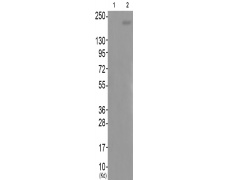中文名稱:兔抗BRCA1(Phospho-Ser1457)多克隆抗體
|
Background: |
This gene encodes a nuclear phosphoprotein that plays a role in maintaining genomic stability, and it also acts as a tumor suppressor. The encoded protein combines with other tumor suppressors, DNA damage sensors, and signal transducers to form a large multi-subunit protein complex known as the BRCA1-associated genome surveillance complex (BASC). This gene product associates with RNA polymerase II, and through the C-terminal domain, also interacts with histone deacetylase complexes. This protein thus plays a role in transcription, DNA repair of double-stranded breaks, and recombination. Mutations in this gene are responsible for approximately 40% of inherited breast cancers and more than 80% of inherited breast and ovarian cancers. Alternative splicing plays a role in modulating the subcellular localization and physiological function of this gene. Many alternatively spliced transcript variants, some of which are disease-associated mutations, have been described for this gene, but the full-length natures of only some of these variants has been described. A related pseudogene, which is also located on chromosome 17, has been identified. [provided by RefSeq, May 2009] |
|
Applications: |
WB |
|
Name of antibody: |
BRCA1(Phospho-Ser1457) |
|
Immunogen: |
Peptide sequence around phosphorylation site of Serine 1457 (L-T-S(p)-Q-K) derived from Human BRCA1. |
|
Full name: |
breast cancer 1, early onset |
|
Synonyms: |
IRIS; PSCP; BRCAI; BRCC1; PNCA4; RNF53; BROVCA1; PPP1R53 |
|
SwissProt: |
P38398 |
|
WB Predicted band size: |
208 kDa |
|
WB Positive control: |
293 cells lysates |
|
WB Recommended dilution: |
500-1000 |

 購物車
購物車 幫助
幫助
 021-54845833/15800441009
021-54845833/15800441009
